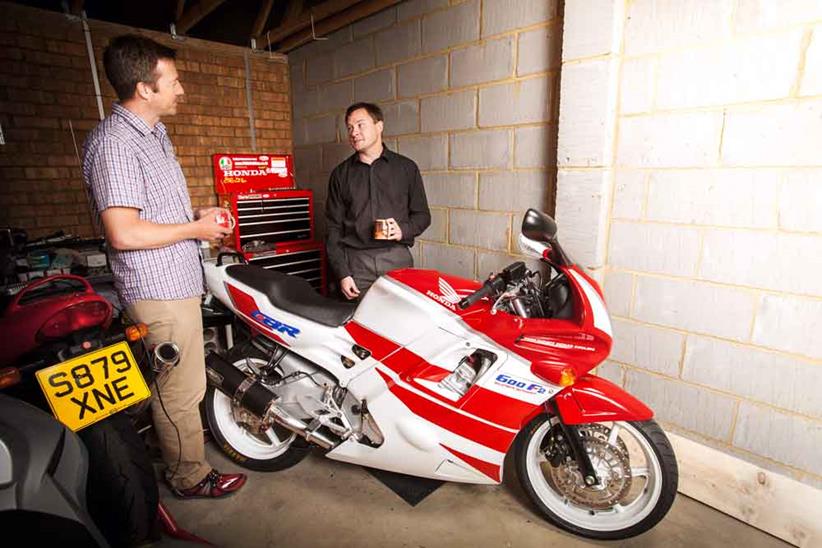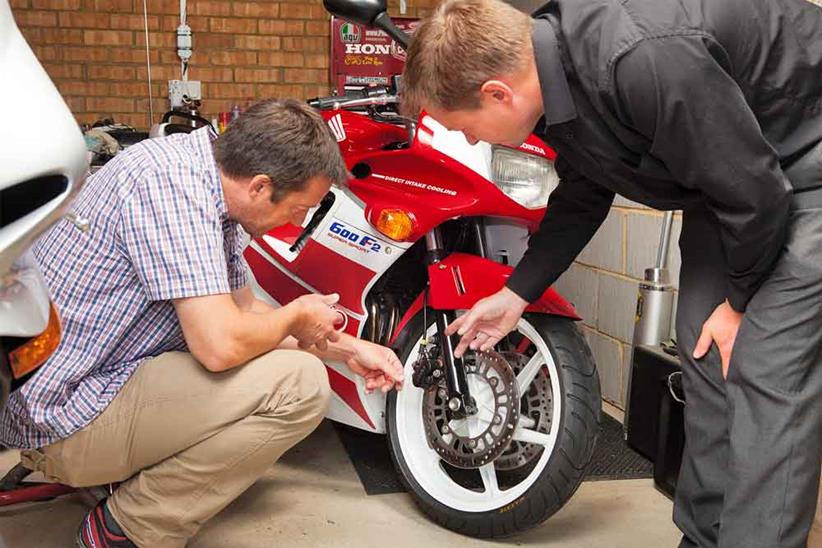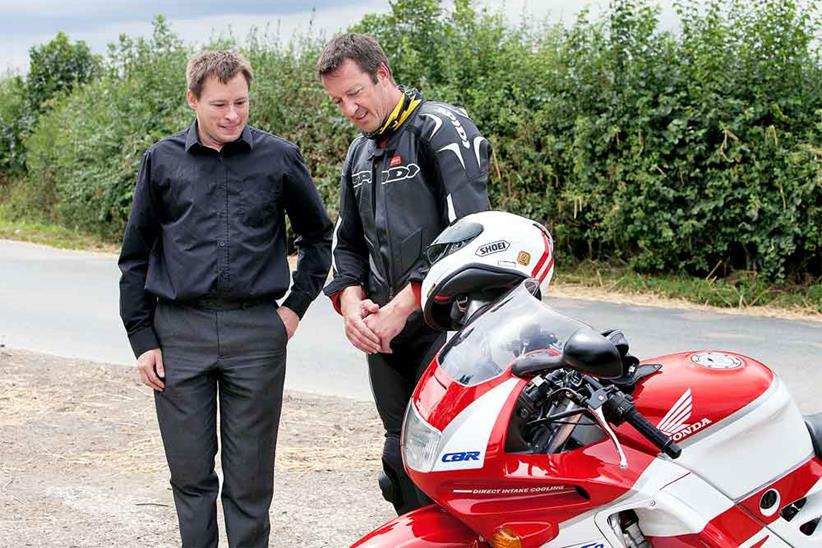CBR600FN restoration
A bad accident left Phillip Harrison with a broken leg, yet over the past two years he’s rehabilitated not only that but this CBR600FN – the latter with some ingenious techniques…
![]() hillip Harrison was riding his daily commute to work when a teenage driver wiped him out. A double-break in his femur, a broken hip, a fractured pelvis and ruptured ligaments in his knee put him in A&E and then on the operating table. Twice. The prognosis didn’t look good. His biking days – at least sportsbike days – looked over.
hillip Harrison was riding his daily commute to work when a teenage driver wiped him out. A double-break in his femur, a broken hip, a fractured pelvis and ruptured ligaments in his knee put him in A&E and then on the operating table. Twice. The prognosis didn’t look good. His biking days – at least sportsbike days – looked over.
“I could’ve taken the decision there and then to stop the bikes, but instead I knew the bikes were a positive,” explains Phillip. “I’ve known and loved them all my life, as have my family, and with the goal of getting back on a sportsbike I had the motivation to push through what was two years of rehabilitation. If I’d taken the view that it was a car for me from here-on in, the chances are I’d be walking with a limp for the rest of my life. But wanting to ride again made me push that much further with the physio and I’ve been able to make a near-complete recovery.”
The accident came just days after he’d been given a Honda CBR600FN. A work colleague had acquired the bike as a resto project but, with a young – and growing – family to attend to, the resto was never going to get started. Phillip had already done an impressive restoration on a Kawasaki GPz550 – formerly his father’s bike that has since been sadly written-off in another non-fault accident – and his mate knew Phillip could make a good job of this bike, too.
“Before the accident I thought I’d do a light recommissioning, with a view to making the CBR a fun, summer-months commuting machine. But once I’d had the accident and realised I wasn’t going to be riding for quite a while, I knew I had the time and inclination to make a full nut-and-bolt restoration.”
The CBR was a runner and Phillip’s mate reported the motor to be in fine health. It was the chassis, the fairings… well, pretty much everything else that let it down. Phillip therefore dealt with the motor by way of a service, setting the valve clearances and then installing a new cam chain tensioner and thermostat. After that, the motor simply got an external clean-up and repaint.
“The clean-up wasn’t simple at all. It was caked in the most god-awful mix of road dirt, grease and rubber, and it proved a nightmare. It took me a month to clean the engine with a Dremel. I tried everything to get it clean. The best thing turned out to be Mr Muscle oven cleaner with a small wire-tooth brush.
“Once cleaned to a good standard, I gave it a light coat of engine paint. It’s not like you have to achieve a perfect finish, because actually that’s not desirable – you want to keep the texture of the castings. If you go too thick the paint will crack because it’s heating up and cooling down separately from the castings, and because it’s not flexible enough the bond breaks down and it flakes. A light dust, just to give it cover, is all it needs.”
![]() With the frame, Phillip checked for correct alignment before sending it off for stripping and powdercoating. It’s a relatively straightforward check on the CBR – if you’ve got a perfectly level surface then the frame should make four clean contact points with the floor. Thankfully, this frame did. Phillip double-checked with a spirit level and a few measurements – all good.
With the frame, Phillip checked for correct alignment before sending it off for stripping and powdercoating. It’s a relatively straightforward check on the CBR – if you’ve got a perfectly level surface then the frame should make four clean contact points with the floor. Thankfully, this frame did. Phillip double-checked with a spirit level and a few measurements – all good.
In the early days of the resto, Phillip worked on sorting the various sub-assemblies. There was stuff that could be taken from his garage into the house, (bedroom, in fact) so he could work on them with his leg comfortably stretched out – and in the warm. The clockset was one such job. The outer housing was broken and when Phillip looked to make a fibreglass repair he found the lenses were, in fact, tape cassette box lids siliconed into place. So he scrapped the housing and started again with a new one sourced from David Silver Spares, together with new lenses. He didn’t need to disturb the clockset and praises Honda for the neat, logical design that allows easy repairs.
Phillip paid particular attention to finishes. He found that the factory alloy-with-a-hint-of-gold-plating on items like the cap over the steering head bearings could be replicated by combining zinc with yellow passivate. He got the footrest hangers soda-blasted, which offers a clean, almost soft finish.
“It’s a very gentle process and gives a nice, sealed finish. An aluminium part that’s been soda-blasted doesn’t need any further finishing and it very closely replicates the silver anodised finish of the original, without having to go to the lengths of anodising. And because it is effectively a sealed finish, not a rough one, it doesn’t pick up fingerprints. That means it’s easy to clean, whereas sand or bead-blasting would stain and look messy.”
As you can imagine, the bodywork was a major element – as it always is with fully-faired bikes. The CBR has no less than 13 individual panels and getting all those back to as-new standard was no small task. Of these, the three sections for the seat and tail were in the best condition and easiest to prepare for repainting.
“Everything else was useable – if you were just going to use it as a ride-to-work bike. There were lots of broken lugs and cracks repaired with fibreglass. One of the panels on the top right had been repaired so many times it wouldn’t sit properly with the lower given the amount of fibreglass, and one lower even had seven coats of paint. My goal was that if you were to take off any panel then it should look exactly as it did when the bike left the factory. I didn’t want to see repairs.”
Some panels came from the ubiquitous eBay. Others were bought new – and yes, that did cost. All, even the brand new panels, had to be prepared for a repaint. Phillip, in a cost-saving act, had sourced a complete sticker kit from Bulgaria (in original FM red-white colours, which he preferred to the FN colour options) and so he had the paint matched to the kit to ensure there were no detracting mismatches. Of course the painter still found filler in the tank along the way, but the repair proved easy and the tank now has 100 per cent integrity.
In rebuilding the bike Phillip decided to renew all bolts and fasteners. Cleaning up and replating all the existing ones proved too expensive, so Phillip decided on four strategies for the full nut-and-bolt job. Engine mount bolts, and other critical bolts that are rated for tensile strength, were cleaned up and replated. For the bodywork, aluminium button-head bolts (by Pro-Bolt) look close-enough to the originals to be an obvious substitution. There are, says Phillip, six special shouldered bolts too, and these he bought OEM at £2 each. For everything else he’s used stainless steel cap-heads bought from a screw supplier.
![]()
Phillip – a precision engineer by trade who specialises in the manual centre lathe – knows about the reactions that different metals have when in contact with one another, and so has taken the appropriate measures. His advice is invaluable…
“One thing is that if you put copperslip on a bolt, you can’t use a torque wrench on it – the reading will be wrong. All torque specifications are for completely clean threads – you’ve got to know what you’re doing. And despite the name, a torque wrench is not a wrench. It’s for measuring.”
As you can imagine with a full nut-and-bolt restoration like this, there’s far more to it than we can cram in here. One thing that surprised us, though, was how Phillip managed this resto on the barest minimum of workshop equipment. He doesn’t even have a bench in his garage, just an old IKEA table and a chair. “I’ve all the hand tools I need – the roll-cab toolbox is a bit of a luxury actually. So yes, I work at the IKEA table, there is a vice – it’s tucked away as I just bolt it to the table as required – and I have a mate with a serious vice if I need it. Realistically, if you’re having to put that much effort into something – like hanging off a socket with a scaffold pole – then you’re probably not approaching the job in the right way. I had an issue with a seized centrestand and I was better off taking it to man with a hydraulic press rather than pounding it with a hammer.”
Phillip got his CBR back together just ahead of the rehabilitation of his leg. The bike fired-up first time and he says he’s been almost perplexed by the complete lack of niggles in the 500 miles he’s ridden since – perhaps that’s just the Honda build quality, he suggests. The restoration has cost more than the market worth, as often happens, but he wasn’t surprised. “If anyone has ever done a full restoration for anything less than one-and-half times the final value I’d say they’ve done well.”
Phillip’s next project has exactly that goal, though. He has an early Yamaha FZR600, in fair condition, and his plan is to have a presentable, solid resto done all-up for under a grand. Given that he’s not intending an all-out showstopper it’ll be an any-weather bike, so the CBR can be kept for best.
Oh, and Phillip’s leg – we didn’t even detect a hint of a limp. Good job all round.
![]() The Honda CBR600 is the very epitome of the term practical sportsbike, only I’d wager that’s underselling the machine. Practical racebike would be more accurate. Of course it’s been much maligned over the years for being safe, or boring, or whatever other insult its detractors can muster. They’re all idiots, though – just look at the records for the Isle of Man TT in the 1990s and you’ll find the CBR won eight out of 10 Supersport/Junior 600 TTs and before then the old jellymould CBR took another two at the end of the 1980s. Say what you will, the CBR600 is the ultimate – race – 600.
The Honda CBR600 is the very epitome of the term practical sportsbike, only I’d wager that’s underselling the machine. Practical racebike would be more accurate. Of course it’s been much maligned over the years for being safe, or boring, or whatever other insult its detractors can muster. They’re all idiots, though – just look at the records for the Isle of Man TT in the 1990s and you’ll find the CBR won eight out of 10 Supersport/Junior 600 TTs and before then the old jellymould CBR took another two at the end of the 1980s. Say what you will, the CBR600 is the ultimate – race – 600.
That’s so obviously evident as I scream Phillip’s recently restored FN model through a bumpy left-hander somewhere in the countryside outside Milton Keynes. I need the speed to make the shot look good (got to have it leant over) and as I approach the corner I’m looking at Phil, stood on a bank, to warn me of any traffic as I dive into the blind left. Mid-corner, despite all manner of bumps and irregularities, the CBR hangs tough; loaded up on the throttle it pulls through, holding its line like a bloodhound. The engine, despite 33,000 miles on the clock, pulls like a factory-tuned racer; upside of 7000rpm it’s mental, and the handling is matching it. Then I hit the brakes to pull up before the next farmyard and the front tyre smears itself to the tarmac while the rear skips a little as it gently unweights, but again it’s total control. Finger-tip subtle. The experience is sublime.
It’s hard to pull back from that assessment. Can I be bothered to mention just how ridiculously civilised the CBR is in everyday use? So comfortable, everything so slick, so immaculate in every detail. Proper mirrors, great instrument set (so clear, so utterly comprehensive), lovely castings, intelligent controls, infallible reliability, brilliant all-day ergonomics and a motor that is as quiet as a Swiss watch. To be honest, that’s all barely worth mentioning. It’s a given.
The CBR is the Clark Kent/Superman of motorcycling – only when it turns into Superman it does so in the most visceral manner imaginable. Sure, it stays true and honest and impossibly well-natured, like a professional assassin, but there’s a dead-eyed, mean-edge too, like if Superman was also a cage fighter on the sly. So bring on your FZRs, your ZZ-Rs, your ZXRs, your GSX-Rs even – the CBR will kick all of their butts. Then moments later it’ll toddle over to the newsagent for the weekend edition of the Telegraph, without so much as a snarl or spit.
If you don’t recognise the CBR in all that then I’m afriad you haven’t been riding it correctly – try and stretch the throttle cable. Properly. Still not quite convinced by it? Well, don’t just listen to me, because I’ve got a bunch of guys here – Morrison, McCallen, Moodie, Duffus, McCallen again, Simpson, Rutter and Moodie again – who could tell you exactly how it is.
Thanks: Stuart and Nicky Peacock for the bike, Ian Shipton and Will Highfield (and their understanding wives) for general help and support, Drew Billham of RS Autos in Bedford (07796 105716) for the paintwork, Lings for the OEM parts (01379 851080), Stotfold Engineers in Biggleswade (01767 318509) for sorting some broken exhaust studs and fitted inserts
Words Jonathan Bentman Photography Simon Hipperson






